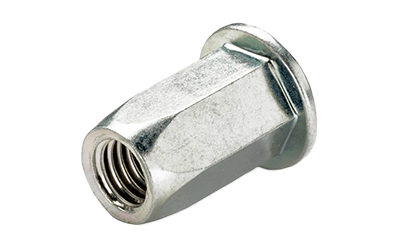What Is a Blind Nut?

A Blind Nut is an embedded type of nut that can be used to make threaded holes in a thin plate.
Normally, when installing threaded holes, the base material must be thicker than the depth of the threaded holes, because the base material is machined using a tap or other tool. Blind Nuts, on the other hand, can be used to make threaded holes in thin plate parts.
Blind Nut is a nut with a female thread inside that is press-fitted into the base material like a rivet. Threaded holes can be installed in thin plates and pipes where female threads cannot be drilled using a tap, thus expanding the range of assembly of thin components.
Uses of Blind Nuts
Blind Nuts are used to install female threads in steel sheets and pipes. These nuts are especially useful in the product assembly process.
When installing a threaded hole in a material by cutting, the material thickness must be greater than the depth of the threaded hole. However, since the thickness of the material is generally determined by the strength and rigidity required, it is not necessarily thicker than the length of the screw engagement.
Blind Nuts are used in such cases to reduce cost, weight, space, and installation man-hours by reducing the thickness of the material.
Principles of Blind Nuts
Blind Nuts are secured by crimping the head (top end) of the nut against a hole in the base metal. The head of the Blind Nut is flanged and stops at the flange when it is threaded through the hole. Therefore, the hole must be drilled according to the outside diameter of the Blind Nut.
A nutter is a special tool for tightening and securing Blind Nuts. First, the nutter is rotated forward against the Blind Nut inserted in the hole, and the threaded portion of the mandrel (shaft) is screwed into the nut. Then, the mandrel is pulled by power to deform the nut, which is then clamped between the flange and the deformed portion of the base material and secured.
Types of Blind Nuts
Blind Nuts vary in their material and shape depending on where they are to be installed. Each has different advantages and disadvantages, so it is important to use them appropriately. The main types of materials used for Blind Nuts are as follows:
1. Aluminum Alloy
Easily available at home centers. It is very easy to handle but not very strong.
2. Steel Material
It is stronger than aluminum alloy and relatively easy to obtain. Rusts when exposed to wind and rain, so choose the right place for installation.
3. Stainless Steel
Stainless steel has the highest strength than aluminum alloy or steel material and requires strong force when caulking because of its hardness. Stainless steel is resistant to rust and can withstand wind and rain, but it is more expensive than aluminum alloy or steel material.
Other Information on Blind Nuts
1. How to Use Blind Nut
Before using Blind Nuts, a hole must be drilled that meets the standard to pass through the Blind Nut. The hole should be one size larger than the body of the Blind Nut. Some Blind Nuts have a thick flange, while others have a flat surface after being tightened.
If you want a thicker nut to be flat, it must be chamfered to allow the flange to fit. There are hand nutters, electric nutters, air nutters, and other types of nutters used to caulk Blind Nuts, depending on the site where they are used.
The threaded part of the mandrel is vulnerable to impact during the crimping operation and is easily damaged.
2. How to Remove Blind Nut
Blind Nuts cannot be removed by ordinary means because they are tightened so that they are sandwiched between a steel plates or other materials. To remove the Blind Nut, its head must be ground off with a sander or similar tool. After the head is ground off, push in the remaining part of the Blind Nut, and it will fall out on the other side.
When the nut is ground off with a sander, the Blind Nut heats up considerably and should not be touched with bare hands. Also, depending on the type of sander, care must be taken because it may also shave off parts other than the Blind Nuts.